Kia Cee'd: Cylinder Block / Cylinder Block Repair procedures
Engine removal is required for this procedure.
(Refer to Engine and transaxle assembly removal in this group)
| 1. |
MT : Remove the flywheel.
(Refet to Cylinder Block - "Flywheel")
|
| 2. |
AT : Remove the drive plate.
(Refet to Cylinder Block - "Drive Plate")
|
| 3. |
Remove the engine to engine stand for disassembly.
|
| 4. |
Remove the timing chain.
(Refet to Timing System - "Timing Chain")
|
| 5. |
Remove the cylinder head.
(Refet to Cylindet Head Assembly - "Cylinder Head")
|
| 6. |
Remove the water jacket.
(Refer to Cylinder Block - "Water Jacket")
|
| 7. |
Remove the oil level gauge tube.
|
| 8. |
Remove the knock sensor (A) and the oil filter (B).
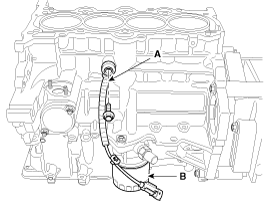
|
| 9. |
Remove the oil pressure switch (A).
(Refet to Lubrication System - "Oil Pressure Switch")
|
| 10. |
Remove the oil pan.
(Refer to Lubrication System - "Oil Pan")
|
| 11. |
Remove the oil screen (A).
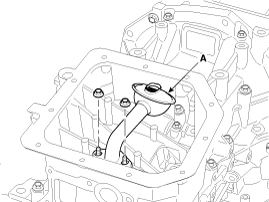
|
| 12. |
Remove the rear oil seal.
(Refet to Cylinder Block - "Rear Oil Seal")
|
| 13. |
Remove the ladder frame(A).

|
| 14. |
Check the connecting rod end play.
|
| 15. |
Remove the connecting rod caps and check oil clearance.
|
| 16. |
Remove the piston and connecting rod assemblies.
| (1) |
Using a ridge reamer, remove all the carbon from the top of
the cylinder.
|
| (2) |
Push the piston, connecting rod assembly and upper bearing through
the top of the cylinder block.
|
• |
Keep the bearings, connecting rod and cap together.
|
|
• |
Arrange the piston and connecting rod assemblies
in the correct order.
|
|
|
|
| 17. |
Remove the crankshaft bearing cap and check oil clearance.
|
| 18. |
Check the crankshaft end play.
|
| 19. |
Lift the crankshaft (A) out of the engine, being careful not to damage
journals.
|
Arrange the main bearings and thrust bearings in the correct
order.
|
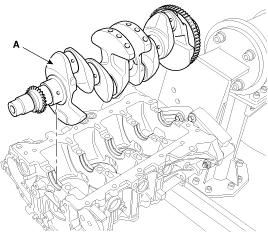
|
| 20. |
Check fit between piston and piston pin.
Try to move the piston back and forth on the piston pin.
If any movement is felt, replace the piston and pin as a set.
|
| 21. |
Remove the piston rings.
| (1) |
Using a piston ring expander, remove the 2 compression rings.
|
| (2) |
Remove the 2 side rails and coil spring.
|
Arrange the piston rings in the correct order only.
|
|
|
| 22. |
Remove the connecting rod from the piston.
Using a press, remove the piston pin from piston.
(Press-in load : 500 ~ 1,500kg(1,102 ~ 3,306lb))
|
| Connecting Rod And Crankshaft |
| 1. |
Check the connecting rod end play.
Using feeler gauge, measure the end play while moving the connecting
rod back and forth.
|
End play
Standard : 0.10 ~ 0.25mm (0.0039 ~ 0.0098in)
Maximum : 0.35mm (0.0138in)
|

| •
|
If out-of-tolerance, install a new connecting rod.
|
| •
|
If still out-of-tolerance, replace the crankshaft.
|
|
|
| 2. |
Check the connecting rod bearing oil clearance.
| (1) |
Check the match marks on the connecting rod and cap are aligned
to ensure correct reassembly.
|
| (2) |
Remove the 2 connecting rod cap bolts.
|
| (3) |
Remove the connecting rod cap and lower bearing.
|
| (4) |
Clean the crankshaft pin journal and bearing.
|
| (5) |
Place a plastigage across the crankshaft pin journal.
|
| (6) |
Reinstall the lower bearing and cap, and tighten the bolts.
Do not reuse the bolts.
|
Tightening torque :
17.7 ~ 21.6N.m (1.8 ~ 2.2kgf.m, 13.0 ~ 15.9lb-ft) +
88 ~ 92°
|
|
Do not turn the crankshaft.
|
|
| (7) |
Remove the 2 bolts, connecting rod cap and lower bearing .
|
| (8) |
Measure the plastigage at its widest point.
|
Standard oil clearance :
0.03 ~ 0.05mm (0.0011 ~ 0.0019in)
|

|
| (9) |
If the measurement from the plastigage is too wide or too narrow,
remove the upper and lower bearing and then install a new bearings
with the same color mark.
Recheck the oil clearance.
|
Do not file, shim, of scrape the bearings or the caps
to adjust clearance.
|
|
| (10) |
If the plastigage shows the clearance is still incorrect, try
the next larger or smaller bearing.
|
If the proper clearance cannot be obtained by using
the appropriate larger or smaller bearings, replace
the crankshaft and restart over.
|
|
If the marks are indecipherable because of an accumulation
of dirt and dust, do not scrub them with a wire brush
or scraper. Clean them only with solvent or detergent.
|
Connecting Rod Mark Location
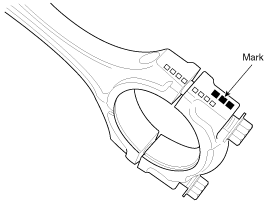
Discrimination Of Connecting Rod
Mark
|
Connecting rod big-end
inner diameter
|
A, 0
|
45.000 ~ 45.006mm (1.7717 ~ 1.7719in)
|
B, 00
|
45.006 ~ 45.012mm (1.7719 ~ 1.7721in)
|
C, 000
|
45.012 ~ 45.018mm (1.7721 ~ 1.7724in)
|
Crankshaft Pin Diameter Mark Location
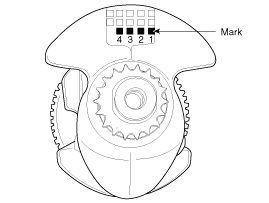
Discrimination Of Crankshaft Pin Diameter
Mark
|
Crankshaft pin outer diameter
|
1
|
41.972 ~ 41.966mm (1.6524 ~ 1.6522in)
|
2
|
41.966 ~ 41.960mm (1.6522 ~ 1.6520in)
|
3
|
41.960 ~ 41.954mm (1.6520 ~ 1.6517in)
|
Connecting Rod Bearing Color Location
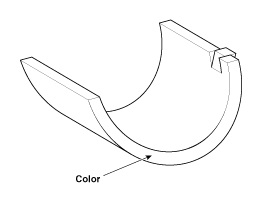
Discrimination Of Connecting Rod Bearing
Mark
|
Color
|
Connecting rod bearing thickness
|
A
|
Blue
|
1.514 ~ 1.517mm (0.0596 ~ 0.0597in)
|
B
|
Black
|
1.511 ~ 1.514mm (0.0595 ~ 0.0596in)
|
C
|
None
|
1.508 ~ 1.511mm (0.0594 ~ 0.0595in)
|
D
|
Green
|
1.505 ~ 1.508mm (0.0593 ~ 0.0594in)
|
E
|
Red
|
1.502 ~ 1.505mm (0.0591 ~ 0.0593in)
|
|
| (11) |
Select the bearing by using selection table.
Connecting Rod Bearing Selection Table
|
Connecting rod mark
|
A, 0
|
B, 00
|
C, 000
|
Crank shaft pin journal mark
|
1
|
E
(Red)
|
D
(Green)
|
C
(None)
|
2
|
D
(Green)
|
C
(None)
|
B
(Black)
|
3
|
C
(None)
|
B
(Black)
|
A
(Blue)
|
|
|
| 3. |
Check the connecting rods.
| (1) |
When reinstalling, make sure that cylinder numbers put on the
connecting rod and cap at disassembly match. When a new connecting
rod is installed, make sure that the notches for holding the
bearing in place are on the same side.
|
| (2) |
Replace the connecting rod if it is damaged on the thrust faces
at either end. Also if step wear or a severely rough surface
of the inside diameter of the small end is apparent, the rod
must be replaced as well.
|
| (3) |
Using a connecting rod aligning tool, check the rod for bend
and twist. If the measured value is close to the repair limit,
correct the rod by a press. Any connecting rod that has been
severely bent or distorted should be replaced.
|
Allowable bend of connecting rod :
0.05mm / 100mm (0.0020in / 3.94in ) or less
Allowable twist of connecting rod :
0.10mm / 100mm (0.0039in / 3.94in) or less
|
|
When the connecting rods installed without bearings,
there should be no difference on side surface.
|
|
|
| 4. |
Check the crankshaft bearing oil clearance.
| (1) |
To check main bearing-to-journal oil clearance, remove the main
bearing caps and lower bearings.
|
| (2) |
Clean each main journal and lower bearing with a clean shop
towel.
|
| (3) |
Place one strip of plastigage across each main journal.
|
| (4) |
Reinstall the lower bearings and caps, then tighten the bolts.
|
Tightening torque :
17.7~21.6Nm (1.8~2.2kgf.m, 13.0~15.9lb-ft) + 88~92°
|
|
Do not turn the crankshaft.
|
|
| (5) |
Remove the cap and lower bearing again, and measure the widest
part of the plastigage.
|
Standard oil clearance
No.1, 2, 3, 4, 5 : 0.020 ~ 0.041mm (0.0007 ~ 0.0016in)
|

|
| (6) |
If the plastigage measures too wide or too narrow, remove the
upper and lower bearing and then install a new bearings with
the same color mark. (Refer to crankshaft main bearing selection
table in this Group).
Recheck the oil clearance.
|
Do not file, shim, or scrape the bearings or the cap
to adjust clearance.
|
|
| (7) |
If the plastigage shows the clearance is still incorrect, try
the next larger or smaller bearing. (Refer to crankshaft main
bearing selection table in this Group).
Recheck the oil clearance.
|
If the proper clearance cannot be obtained by using
the appropriate larger or smaller bearings, replace
the crankshaft and start over.
|
|
If the marks are indecipherable because of an accumulation
of dirt and dust, do not scrub them with a wire brush
or scraper. Clean them only with solvent or detergent.
|
Cylinder block crankshaft journal bore mark location
Letters have been stamped on the side surface of the block as
a mark for the size of each of the 5 main journal bores.
Use them, and the numbers or letters stamped on the crank (marks
for main journal size), to choose the correct bearings.
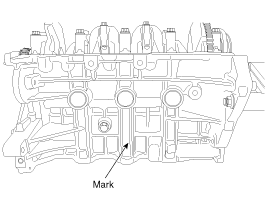
Discrimination Of Cylinder Block Crankshaft Journal Bore
Mark
|
Cylinder block crankshaft journal bore
inner diameter
|
A
|
52.000 ~ 52.006mm (2.0472 ~ 2.0475in)
|
B
|
52.006 ~ 52.012mm (2.0475 ~ 2.0477in)
|
C
|
52.012 ~ 52.018mm (2.0477 ~ 2.0479in)
|
Crankshaft Main Journal Mark Location
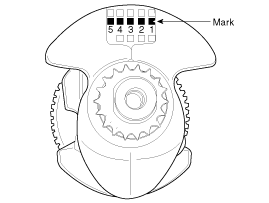
Discrimination Of Crankshaft Main Journal
Mark
|
Crankshaft main journal
outer diameter
|
1
|
47.960 ~ 47.954mm (1.8882 ~ 1.8879in)
|
2
|
47.954 ~ 47.948mm (1.8879 ~ 1.8877in)
|
3
|
47.948 ~ 47.942mm (1.8877 ~ 1.8875in)
|
Crankshaft Main Bearing Color Location
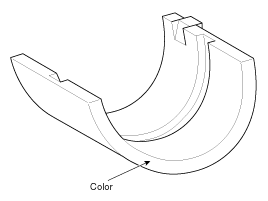
Discrimination Of Crankshaft Main Bearing
Mark
|
Color
|
Crankshaft main bearing thickness
|
No.1, 2, 3, 4, 5
|
A
|
Blue
|
2.026 ~ 2.029mm (0.0798 ~ 0.0799in)
|
B
|
Black
|
2.023 ~ 2.026mm (0.0796 ~ 0.0798in)
|
C
|
None
|
2.020 ~ 2.023mm (0.0795 ~ 0.0796in)
|
D
|
Green
|
2.017 ~ 2.020mm (0.0794 ~ 0.0795in)
|
E
|
Red
|
2.014 ~ 2.017mm (0.0793 ~ 0.0794in)
|
|
| (8) |
Select the bearing by using selection table.
Crankshaft Main Bearing Selection Table
|
Cylinder block crankshaft journal bore mark
|
A
|
B
|
C
|
Crank shaft main journal mark
|
1
|
E
(Red)
|
D
(Green)
|
C
(None)
|
2
|
D
(Green)
|
C
(None)
|
B
(Black)
|
3
|
C
(None)
|
B
(Black)
|
A
(Blue)
|
|
|
| 5. |
Check the crankshaft end play.
Using a dial indicator, measure the thrust clearance while prying the
crankshaft back and forth with a screwdriver.
|
End play
Standard: 0.05 ~ 0.25mm (0.0020 ~ 0.0098in)
Limit : 0.30mm (0.0118in)
|
If the end play is greater than maximum, replace the center bearing.
|
Cylinder Block
| 1. |
Remove the gasket material.
Using a gasket scraper, remove all the gasket material from the top
surface of the cylinder block.
|
| 2. |
Clean the cylinder block
Using a soft brush and solvent, thoroughly clean the cylinder block.
|
| 3. |
Inspect the top surface of cylinder block for flatness.
Using a precision straight edge and feeler gauge, measure the surface
contacting the cylinder head gasket for warpage.
|
Flatness of cylinder block gasket surface
Standard :
Less than 0.05mm (0.0020in) for total area
Less than 0.02mm (0.0008in) for a section of 100mm (3.9370in)
X 100mm (3.9370in)
|

|
| 4. |
Inspect the cylinder bore.
Visually check the cylinder for vertical scratchs.
If deep scratchs are present, replace the cylinder block.
|
| 5. |
Inspect the cylinder bore diameter.
Using a cylinder bore gauge, measure the cylinder bore diameter at position
in the thrust and axial direction.
|
Standard diameter :
77.00 ~ 77.03mm (3.0315 ~ 3.0327in)
|
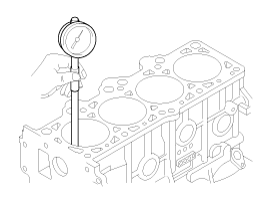
|
| 6. |
Check the cylinder bore size code on the cylinder block side surface.
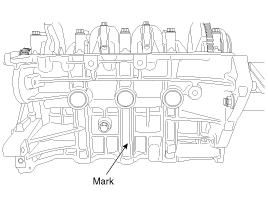
Discrimination Of Cylinder Bore Size
Mark
|
Cylinder bore inner diameter
|
A
|
77.00 ~ 77.01mm (3.0315 ~ 3.0319in)
|
B
|
77.011 ~ 77.020mm (3.0319 ~ 3.0322in)
|
C
|
77.021 ~ 77.030mm (3.0323 ~ 3.0326in)
|
|
| 7. |
Check the piston size mark (A) on the piston top face.
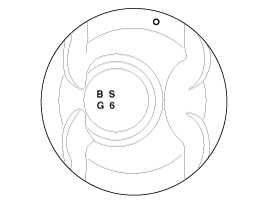
A : Grade
S : ISG type
G : Gasoline engine
6 : 1.6L
Discrimination Of Piston Outer Diameter
Mark
|
Piston outer diameter
|
A
|
76.97 ~ 76.98mm (3.0303 ~ 3.0307in)
|
B
|
76.98 ~ 76.99mm (3.0307 ~ 3.0311in)
|
C
|
76.99 ~ 77.00mm (3.0311 ~ 3.0315in)
|
|
| 8. |
Select the piston related to cylinder bore class.
|
Piston -to-cylinder clearance :
0.02 ~ 0.04mm (0.0008 ~ 0.0016in)
|
|
Piston And Piston Rings
| 1. |
Clean the piston.
| (1) |
Using a gasket scraper, remove the carbon from the piston top.
|
| (2) |
Using a groove cleaning tool or broken ring, clean the piston
ring grooves.
|
| (3) |
Using solvent and a brush, thoroughly clean the piston.
|
|
| 2. |
The standard measurement of the piston outside diameter is taken 12mm(0.4724in)
from bottom land of the piston.
|
Standard diameter :
76.97 ~ 77.00mm (3.0303 ~ 3.0315in)
|

|
| 3. |
Calculate the difference between the cylinder bore inner diameter and
the piston outer diameter.
|
Piston-to-cylinder clearance :
0.02 ~ 0.04mm (0.0008 ~ 0.0016in)
|
|
| 4. |
Inspect the piston ring side clearance.
Using a feeler gauge, measure the clearance between new piston ring
and the wall of ring groove.
|
Piston ring side clearance
No.1 ring : 0.04 ~ 0.08mm (0.0016 ~ 0.0031in)
No.2 ring : 0.04 ~ 0.08mm (0.0016 ~ 0.0031in)
Oil ring : 0.02 ~ 0.06mm (0.0008 ~ 0.0024in)
Limit
No.1 ring : 0.1mm (0.0039in)
No.2 ring : 0.1mm ( 0.0039in)
Oil ring : 0.2mm ( 0.0079in)
|
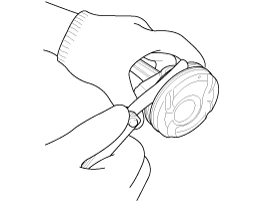
If the clearance is greater than maximum, replace the piston.
|
| 5. |
Inspect the piston ring end gap.
To measure the piston ring end gap, insert a piston ring into the cylinder
bore. Position the ring at right angles to the cylinder wall by gently
pressing it down with a piston. Measure the gap with a feeler gauge.
If the gap exceeds the service limit, replace the piston rings. If the
gap is too large, recheck the cylinder bore inner diameter. If the bore
is over the service limit, the cylinder block must be rebored.
|
Piston ring end gap
Standard
No.1 ring : 0.14 ~ 0.28mm (0.0079 ~ 0.0138in)
No.2 ring : 0.30 ~ 0.45mm (0.0118 ~ 0.0177in)
Oil ring : 0.20 ~ 0.40mm(0.0079 ~ 0.0157in)
Limit
No.1 ring : 0.3mm(0.0118in)
No.2 ring : 0.5mm(0.0197in)
Oil ring : 0.8mm(0.0315in)
|
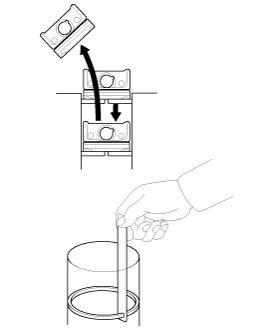
|
Piston Pins
| 1. |
Measure the outer diameter of piston pin
|
Piston pin diameter :
18.001 ~ 18.006mm (0.7087 ~ 0.7089in)
|
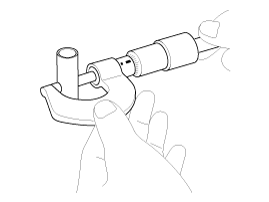
|
| 2. |
Measure the piston pin-to-piston clearance.
|
Piston pin-to-piston clearance :
0.010 ~ 0.020mm (0.0004 ~ 0.0008in)
|
|
| 3. |
Check the difference between the piston pin outer diameter and the connecting
rod small end inner diameter.
|
Piston pin-to-connecting rod interference :
-0.032 ~ -0.016mm (-0.0013 ~ -0.0006in)
|
|
| • |
Thoroughly clean all parts to assembled.
|
| • |
Before installing the parts, apply fresh engine oil to all sliding
and rotating surfaces.
|
| • |
Replace all gaskets, O-rings and oil seals with new parts.
|
|
| 1. |
Assemble the piston and connecting rod.
| (1) |
Use a hydraulic press for installation.
|
| (2) |
The piston front mark (A) and the connecting rod front mark
(A) must face the timing chain side of the engine.
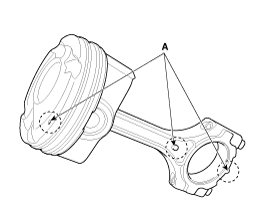
|
|
| 2. |
Install the piston rings.
| (1) |
Install the oil ring coil spring and 2 side rails by hand.
|
| (2) |
Using a piston ring expander, install the 2 compression rings
with the code mark facing upward.
|
| (3) |
Position the piston rings so that the ring ends are as shown.

|
|
| 3. |
Install the connecting rod bearings.
| (1) |
Align the bearing (A) claw with the groove of the connecting
rod or connecting rod cap (B).
|
| (2) |
Install the bearings (A) in the connecting rod and connecting
rod cap (B).

|
|
| 4. |
Install the crankshaft main bearings.
| (1) |
Align the bearing claw with the claw groove of the cylinder
block, push in the five upper bearings(A).
|
Upper bearings have an oil groove of oil holes ; Lower
bearings do not.
|

|
| (2) |
Align the bearing claw with the claw groove of the main bearing
cap, and push in the 5 lower bearings.
|
|
| 5. |
Install the thrust bearing.
Install the thrust bearing (A) on the No.3 journal position of the cylinder
block with the oil grooves facing outward.
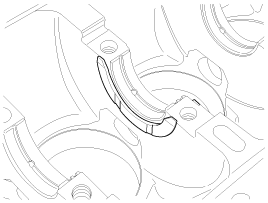
|
| 6. |
Place the crankshaft on the cylinder block.
|
| 7. |
Place the main bearing caps on the cylinder block.
|
| 8. |
Install the main bearing cap bolts.
|
The main bearing cap bolts are tightened in 2 progressive steps.
If any of the bearing cap bolts in broken or deformed, replace
it.
|
| (1) |
Apply a light coat of engine oil on the threads and under the
bearing cap bolts.
|
| (2) |
Install and uniformly tighten the 10 bearing cap bolts, in several
passes, in the sequence shown.
|
Tightening torque :
17.7~21.6Nm (1.8~2.2kgf.m, 13.0~15.9lb-ft) + 88~92°
|
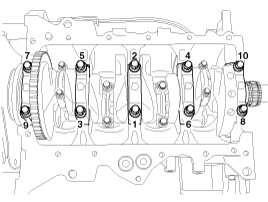
|
Do not reuse the main bearing cap bolts.
|
|
| (3) |
Check that the crankshaft turns smoothly.
|
|
| 9. |
Check the crankshaft end play.
|
| 10. |
Install the piston and connecting rod assemblies.
|
Before installing the piston, apply a coat of engine oil to
the ring grooves and cylinder bores.
|
| (1) |
Install the ring compressor, check that the rings are securely
in place, then position the piston in the cylinder, and tap
it in using the wooden handle of a hammer.
|
| (2) |
Stop after the ring compressor pops free, and check the connecting
rod-to-crank journal alignment before pushing the piston into
place.
|
| (3) |
Stop after the ring compressor pops free, and check the connecting
rod-to-crank journal alignment before pushing the piston into
place.
|
Tightening torque :
17.7~21.8Nm (1.8~2.2kgf.m, 13.0~15.9lb-ft) + 88~92°
|
|
Do not reuse the connecting rod cap bolts.
|
|
|
| 11. |
Apply the sealant on the ladder frame.
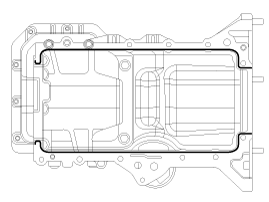
| •
|
Apply the sealant, THREE-BOND 1217H or LOCTITE 5900H
on the ladder frame rail portion and install it with
in five minutes.
|
| •
|
If when sealant is applied to cylinder block bottom
position, sealant position to be same with positon that
is applied to ladder frame rail position.
|
| •
|
Apply sealant along the inner line of the bolt holes.
|
|
|
| 12. |
Install the ladder frame (A).
|
Tightening torque :
18.6 ~ 24.2N.m (1.9 ~ 2.4kgf.m, 13.7 ~ 17.4lb-ft)
|

|
| 13. |
Install the rear oil seal.
(Refer to Cylinder Block - "Rear Oil Swal")
|
| 14. |
Install the oil screen (A).
Install a new gasket and oil screen with 2 bolts.
|
Tightening torque :
24.5 ~ 31.4N.m (2.5 ~ 3.2kgf.m, 18.1 ~ 23.1lb-ft)
|

|
| 15. |
Install the oil pan.
(Refer to Lubrication System - "Oil Pan")
|
| 16. |
Install the oil pressure switch.
(Refet to Lubrication System - "Oil Pressure Switch")
|
| 17. |
Install the knock sensor and the oil filter.
(Refet to Lubrication System - "Oil Filter")
|
| 18. |
Install the oil level gauge tube.
|
| 19. |
Install the water jacket.
(Refer to Cylinder Block - "Water Jacket Separator")
|
| 20. |
Install the timing chain.
(Refet to Timing System - "Timing Chain")
|
| 21. |
Inatall the cylinder head.
(Refet to Cylindet Head Assembly - "Cylinder Head")
|
| 22. |
Disconnect the engine stand.
|
| 23. |
AT : Install the drive plate.
(Refet to Cylinder Block - "Drive Plate")
|
| 24. |
MT : Install the flywheel.
(Refet to Cylinder Block - "Flywheel")
|
| 25. |
Install the engine.
(Refer to Engine and transaxle assembly - "Engine and transaxle Assembly")
|
Components
1. Cylinder block
2. Ladder frame
3. Crank shaft
4. Crank shaft upper bearing
5. Crank shaft lower bearin ...
 Cylinder Block Components and components location
Cylinder Block Components and components location Cooling System
Cooling System





























